8.2.6: Finding Distances in the Coordinate Plane
- Page ID
- 37742
\( \newcommand{\vecs}[1]{\overset { \scriptstyle \rightharpoonup} {\mathbf{#1}} } \)
\( \newcommand{\vecd}[1]{\overset{-\!-\!\rightharpoonup}{\vphantom{a}\smash {#1}}} \)
\( \newcommand{\id}{\mathrm{id}}\) \( \newcommand{\Span}{\mathrm{span}}\)
( \newcommand{\kernel}{\mathrm{null}\,}\) \( \newcommand{\range}{\mathrm{range}\,}\)
\( \newcommand{\RealPart}{\mathrm{Re}}\) \( \newcommand{\ImaginaryPart}{\mathrm{Im}}\)
\( \newcommand{\Argument}{\mathrm{Arg}}\) \( \newcommand{\norm}[1]{\| #1 \|}\)
\( \newcommand{\inner}[2]{\langle #1, #2 \rangle}\)
\( \newcommand{\Span}{\mathrm{span}}\)
\( \newcommand{\id}{\mathrm{id}}\)
\( \newcommand{\Span}{\mathrm{span}}\)
\( \newcommand{\kernel}{\mathrm{null}\,}\)
\( \newcommand{\range}{\mathrm{range}\,}\)
\( \newcommand{\RealPart}{\mathrm{Re}}\)
\( \newcommand{\ImaginaryPart}{\mathrm{Im}}\)
\( \newcommand{\Argument}{\mathrm{Arg}}\)
\( \newcommand{\norm}[1]{\| #1 \|}\)
\( \newcommand{\inner}[2]{\langle #1, #2 \rangle}\)
\( \newcommand{\Span}{\mathrm{span}}\) \( \newcommand{\AA}{\unicode[.8,0]{x212B}}\)
\( \newcommand{\vectorA}[1]{\vec{#1}} % arrow\)
\( \newcommand{\vectorAt}[1]{\vec{\text{#1}}} % arrow\)
\( \newcommand{\vectorB}[1]{\overset { \scriptstyle \rightharpoonup} {\mathbf{#1}} } \)
\( \newcommand{\vectorC}[1]{\textbf{#1}} \)
\( \newcommand{\vectorD}[1]{\overrightarrow{#1}} \)
\( \newcommand{\vectorDt}[1]{\overrightarrow{\text{#1}}} \)
\( \newcommand{\vectE}[1]{\overset{-\!-\!\rightharpoonup}{\vphantom{a}\smash{\mathbf {#1}}}} \)
\( \newcommand{\vecs}[1]{\overset { \scriptstyle \rightharpoonup} {\mathbf{#1}} } \)
\( \newcommand{\vecd}[1]{\overset{-\!-\!\rightharpoonup}{\vphantom{a}\smash {#1}}} \)
Lesson
Let's find distances in the coordinate plane.
Exercise \(\PageIndex{1}\): Closest Distance
- Order the following pairs of coordinates from closest to farthest apart. Be prepared to explain your reasoning.
- \((2,4)\) and \((2,10)\)
- \((-3,6)\) and \((5,6)\)
- \((-12,-12)\) and \((-12,-1)\)
- \((7,0)\) and \((7,-9)\)
- \((1,-10)\) and \((-4,-10)\)
- Name another pair of coordinates that would be closer together than the first pair on your list.
- Name another pair of coordinates that would be farther apart than the last pair on your list.
Exercise \(\PageIndex{2}\): How Far Apart?
Find the distances between the three points shown.
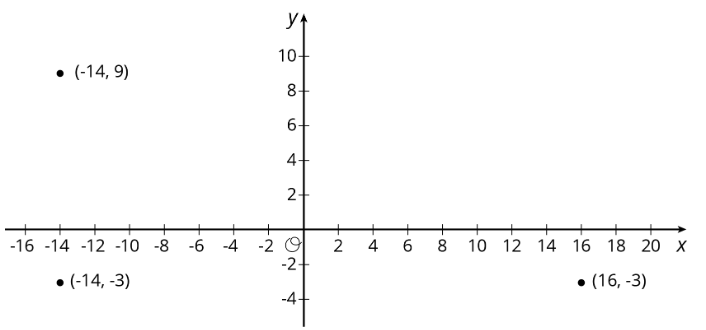
Exercise \(\PageIndex{3}\): Perimeters with Pythagoras
- Which figure do you think has the longer perimeter?
- Select one figure and calculate its perimeter. Your partner will calculate the perimeter of the other. Were you correct about which figure had the longer perimeter?

Are you ready for more?
Quadrilateral \(ABCD\) has vertices at \(A=(-5,1),\: B=(-4,4),\: C=(2,2)\), and \(D=(1,-1)\).
- Use the Pythagorean Theorem to find the lengths of sides \(AB\), \(BC\), \(CD\), and \(AD\).
- Use the Pythagorean Theorem to find the lengths of the two diagonals, \(AC\) and \(BD\).
- Explain why quadrilateral \(ABCD\) is a rectangle.
Exercise \(\PageIndex{4}\): Finding the Right Distance
Have each person in your group select one of the sets of coordinate pairs shown here. Then calculate the length of the line segment between those two coordinates. Once the values are calculated, have each person in the group briefly share how they did their calculations.
- \((-3,1)\) and \((5,7)\)
- \((-1,-6)\) and \((5,2)\)
- \((-1,-2)\) and \((5,-6)\)
- \((-2,-5)\) and \((6,1)\)
- How does the value you found compare to the rest of your group?
- In your own words, write an explanation to another student for how to find the distance between any two coordinate pairs.
Summary
We can use the Pythagorean Theorem to find the distance between any two points on the coordinate plane. For example, if the coordinates of point \(A\) are \((-2,-3)\), and the coordinates of point \(B\) are \((-8,4)\), let’s find the distance between them. This distance is also the length of line segment \(AB\). It is a good idea to plot the points first.

Think of the distance between \(A\) and \(B\), or the length of segment \(AB\), as the hypotenuse of a right triangle. The lengths of the legs can be deduced from the coordinates of the points.

The length of the horizontal leg is 6, which can be seen in the diagram, but it is also the distance between the \(x\)-coordinates of \(A\) and \(B\) since \(|-8--2|=6\). The length of the vertical leg is 7, which can be seen in the diagram, but this is also the distance between the \(y\)-coordinates of \(A\) and \(B\) since \(|-4--3|=7\).
Once the lengths of the legs are known, we use the Pythagorean Theorem to find the length of the hypotenuse, \(AB\), which we can represent with \(c\). Since \(c\) is a positive number, there is only one value it can take:
\[\begin{aligned} 6^{2}+7^{2}&=c^{2}\\ 36+49&=c^{2}\\ 85&=c^{2} \\ \sqrt{85}&=c\end{aligned}\nonumber\]
This length is a little longer than 9, since 85 is a little longer than 81. Using a calculator gives a more precise answer, \(\sqrt{85}\approx 9.22\).
Glossary Entries
Definition: Pythagorean Theorem
The Pythagorean Theorem describes the relationship between the side lengths of right triangles.
The diagram shows a right triangle with squares built on each side. If we add the areas of the two small squares, we get the area of the larger square.
The square of the hypotenuse is equal to the sum of the squares of the legs. This is written as \(a^{2}+b^{2}=c^{2}\).
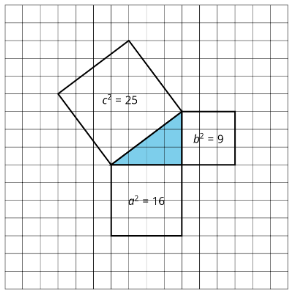
Definition: Hypotenuse
The hypotenuse is the side of a right triangle that is opposite the right angle. It is the longest side of a right triangle.
Here are some right triangles. Each hypotenuse is labeled.
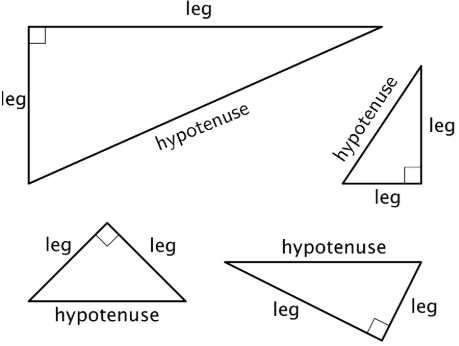
Definition: LEgs
The legs of a right triangle are the sides that make the right angle.
Here are some right triangles. Each leg is labeled.

Practice
Exercise \(\PageIndex{5}\)
The right triangles are drawn in the coordinate plane, and the coordinates of their vertices are labeled. For each right triangle, label each leg with its length.
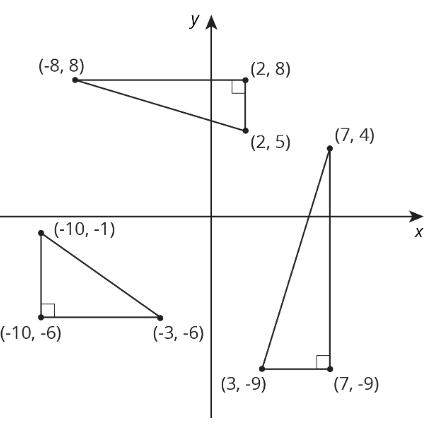
Exercise \(\PageIndex{6}\)
Find the distance between each pair of points. If you get stuck, try plotting the points on graph paper.
- \(M=(0,-11)\) and \(P=(0,2)\)
- \(A=(0,0)\) and \(B=(-3,-4)\)
- \(C=(9,0)\) and \(D=(0,-6)\)
Exercise \(\PageIndex{7}\)
- Find an object that contains a right angle. This can be something in nature or something that was made by humans or machines.
- Measure the two sides that make the right angle. Then measure the distance from the end of one side to the end of the other.
- Draw a diagram of the object, including the measurements.
- Use the Pythagorean Theorem to show that your object really does have a right angle.
(From Unit 8.2.4)
Exercise \(\PageIndex{8}\)
Which line has a slope of 0.625, and which line has a slope of 1.6? Explain why the slopes of these lines are 0.625 and 1.6.

(From Unit 2.3.1)
Exercise \(\PageIndex{9}\)
Write an equation for the graph.
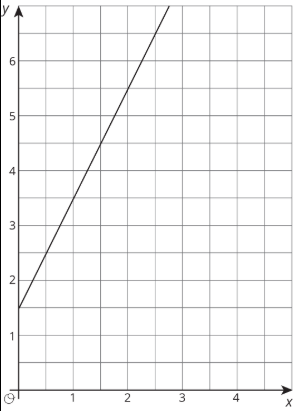
(From Unit 3.2.3)


